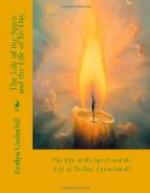These objects of religious cultus, then, and the whole symbolic faith-world which is built up of them, with its angels and demons, its sharply defined heaven and hell, the Divine personifications which embody certain attributes of God for us, the purity and gentleness of the Mother, the simplicity and infinite possibility of the Child, the divine self-giving of the Cross;—more, the Lamb, the Blood and the Fire of the revivalists, the oil and water, bread and wine, of a finished Sacramentalism—all these may be regarded as the vestures placed by man, at one stage or another of his progress, on the freely-given but ineffable spiritual fact. Like other clothes, they have now become closely identified with that which wears them. And we strip them off at our own peril: for this proceeding, grateful as it may be to our intellects, may leave us face to face with a mystery which we dare not look at, and cannot grasp.
So, cultus has done a mighty thing for humanity, in evolving and conserving the system of symbols through which the Infinite and Eternal can be in some measure expressed. The history of these symbols goes back, as we now know, to the infancy of the race, and forward to the last productions of the religious imagination; all of which bear the image of our past They are like coins, varying in beauty, and often of slight intrinsic value; but of enormous importance for our spiritual currency, because accepted as the representatives of a real wealth. In its symbols, the cultus preserves all the past levels of religious response achieved by the race; weaving them into the fabric of religion, and carrying them forward into the present. All the instinctive movements of the primitive mind; its fear of the invisible, its self-subjection, its trust in ritual acts, amulets, spells, sacrifices, its tendency to localize Deity in certain places or shrines, to buy off the unknown, to set up magicians and mediators, are represented in it. Its function is racial more than individual. It is the art-work of the folk-soul in the religious sphere. Here man’s inveterate creative faculty seizes on the raw material given him by religious-intuition, and constructs from it significant shapes. We misunderstand, then, the whole character of religious symbolism if we either demand rationality from it, or try to adapt its imagery to the lucid and probably mistaken conclusions of the sophisticated, modern mind.
We are learning to recognize these primitive and racial elements in popular religion, and to endure their presence with tolerance; because they are necessary, and match a level of mental life which is still active in the race. This more primitive life emerges to dominate all crowds—where the collective mental level is inevitably lower than that of the best individuals immersed in it—and still conditions many of our beliefs and deeds. There is the propitiatory attitude to unseen Divine powers; which the primitive mind, in defiance of theology,




